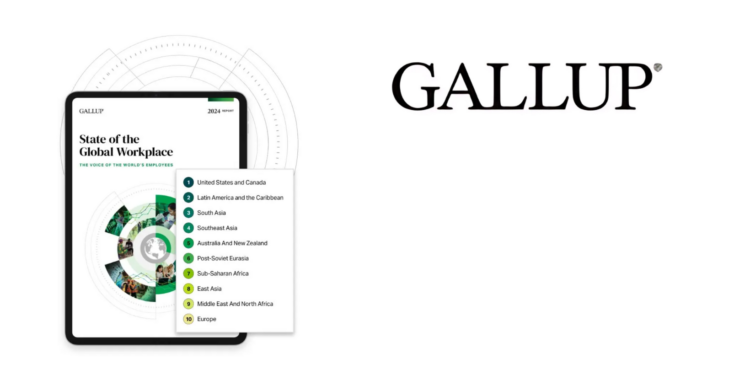Washington, D.C., June 12, 2024 — Gallup’s latest State of the Global Workplace report reveals that global employee engagement stagnated and employee wellbeing declined in 2023 after multiple years of steady gains. This stagnation leaves a majority of the world’s employees struggling at work and in life, significantly impacting organizational productivity.
Employee Engagement
The lack of improvement in both employee engagement and wellbeing is notable, particularly after several years of consistent gains. The U.S. and Canada lead with the highest regional percentage of engaged employees at 33%, compared to a global average of 23%. In these regions, women exhibit higher engagement (35%) than men (31%).
Gallup estimates that low engagement costs the global economy $8.9 trillion, or 9% of global GDP, enough to influence the success of global development goals.
“Employee engagement has become increasingly important as the globe has entered uncertain economic times. Our research has shown that engagement has a stronger effect on organizational performance during a tough economy,” said Jim Harter, Gallup’s chief workplace scientist.
The Role of Work in Employee Mental Health and Wellbeing
Employee engagement significantly affects overall life experiences. While not all mental health issues stem from work, work influences life evaluations and daily emotions. Addressing employee mental health involves supporting both thriving in life and engagement at work.
The U.S. and Canada have the third-highest regional percentage of thriving employees at 53%, compared to a global average of 34%. Additionally, 20% of the world’s employees reported experiencing a lot of loneliness the previous day. Social isolation and chronic loneliness severely impact physical and mental health, but work itself can mitigate loneliness, as working adults generally feel less lonely than the global average.
The percentage of younger employees thriving has declined in the past year, with a global drop from 35% to 34%. This decline was most pronounced among workers under 35.
The Role of the Manager in Worker Wellbeing and Organizational Success
Managers globally are more likely than non-managers to be engaged at work and thriving in life, but they are also more prone to stress, anger, sadness, and loneliness. The U.S. and Canada have the second-highest regional percentage of employees experiencing stress at 49%, compared to a global average of 41%, with women experiencing higher stress levels (54%) than men (45%).
Gallup finds that when managers are engaged, non-manager employees are more likely to be engaged. Effective management through goal setting, regular, meaningful feedback, and accountability drives engagement. Although only 30% of managers and 23% of employees overall are engaged globally, some organizations achieve much higher levels of engagement and wellbeing.
The shift to hybrid work has complicated people management since 2020. Increasing the number of engaged employees improves various organizational outcomes.
“A core habit for effective management is providing weekly meaningful feedback for each person on your team. Physical distance often translates into psychological distance, so this becomes a critical skill for hybrid and remote work. Our data suggest that most managers don’t have a handle yet on effective hybrid and remote work management. It can be done, but it requires greater levels of intentionality and communication,” Harter added.
About Gallup
Gallup delivers analytics and advice to help leaders and organizations solve their most pressing problems. With over 80 years of experience and global reach, Gallup provides unparalleled insights into the attitudes and behaviors of employees, customers, students, and citizens.
Read Also : Imagination in a Disrupted Age: Navigating the Future with Curiosity and Empathy












